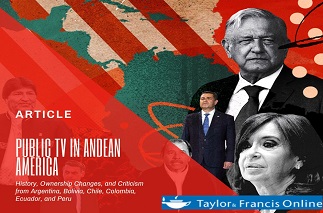
Populist attitudes and perceptions of public opinion and the media: A comparative correlational study between Spain and Colombia
Populism has experienced a worrying growth in the last decade in different locations around the world. This globalizing process has been enhanced by the immediacy, interaction, and participation of social networks, cyber media, and other digital platforms. In this context, the perception that young people give to this type of phenomena constitutes a field of study of great interest for the Social Sciences. This research examines the correlations between populist attitudes, perception of public opinion, and opinions about the media in students of Communication Sciences in Colombia and Spain. Methods: Based on an exploratory-correlational approach and a quantitative design, this research has analyzed the reflections and priorities of a group of n=499 undergraduate and graduate students related to Communication Sciences in Colombia and Spain. Results: The study has confirmed the leading role played by social networks in the formation of radical opinions while detecting a decline in the influence of television among young audiences. In addition, the study establishes that the index of public opinion perception is higher in Spain, while the index of media perception or anti-elitist attitudes is higher in Colombia, and there is no clear link between populist attitudes and a political ideology of extremes. Conclusions: The correlations examined note a tendency towards disaffection and discredit towards politics in general, especially by the young population, which affects actors and institutions. It alludes to the preference of this population group for interacting and informing themselves on digital platforms and presents populist attitudes, without clear ideological identification, but with a clear tendency towards simplification of messages, thus emphasizing the need to educate the critical view of citizens and to work on media literacy as a crucial strategy against the growth and expansion of populism.

Symbolic-discursive violence and new media: An epistemological perspective
The following research studies, from a theoretical perspective, the different forms of symbolic and discursive violence and the transmission of hate speech through new media. The main objective is to understand the consequences of symbolic violence through language and how this affects freedom of expression. Reflective and critical argumentation is highlighted through an exploratory analysis carried out by a literature review, where it is determined that the confrontational narrative used by the media contributes to the dehumanization, demonization and polarization of specific collectives.

The cinema of cruelty in streaming: elements of perversity in Chernobyl and years and years
This study aims to diagnose how the cinema of cruelty has been inserted into mainstream culture through the current streaming series, analysing the elements of the eroticism of perversity and the cinema of cruelty in the series Chernobyl and Years and Years (HBO: 2019). This is done with the design of a content analysis sheet based on the interpretation of theoretical constructs, validated by expert judgement. The results diagnose an excess of trivialised cruelty, evidencing the spectator’s desensitisation to the images, as well as their fascination with them. In this sense, the growing audiovisual success of misanthropic, entertaining, and pornographic narratives is evident. It is concluded that discomfort, fun, horror pornography, and their respective prestige, are installed in contemporary popular television culture, reproducing a relationship between the depressing and the entertainment.

The «ventriloquist effect» of the international news agencies. Theoretical review and incidence on new forms of misinformation
This research reflects, from a theoretical perspective, how most of the international events that reach the rest of the media are disseminated through news agencies, causing the well-known «ventriloquist effect»: multiple media, a single voice; and explores how online platforms have fostered this phenomenon, causing a structural increase in misinformation. In this sense, the research aims to understand the development of the «ventriloquist effect» with the progress of «new media» and, as a consequence, the increase of disinformation. For this grounded theory documentary analysis, the methodological procedure was based on the bibliographic review of the literature in the international reference databases (WoS and Scopus), carrying out an analysis of primary studies to synthesize the information. The results indicate, among other issues, that social networks foster spaces of structural misinformation in the current ecosystem. In conclusion, the relationship between the "ventriloquist effect" and misinformation, which arises from reticularly and information-digital decentralization, is determined.

How to Botox’ on YouTube: Influence and Beauty Procedures in the Era of User-Generated Content
The current media environment is complex and has important effects on all aspects of life, including beauty and health. In this sense, YouTube has become one of the main contexts for the dissemination of tutorials and content related to medical procedures such as the application of Botox. Thus, the present study constitutes the first exploratory analysis of YouTube videos in Spanish related to this procedure. A preliminary analysis of 221 YouTube videos yielded a final sample of the 50 most viewed videos within this genre. The analysis was carried out through a quantitative content analysis assessing the popularity of the videos, contact and emotive strategies by the creator, the credibility conveyed, and the characteristics of information about the procedure itself. Results suggest that these influencers align with mainstream Internet celebrity culture in practices that aim at increasing their following and views, as well as calls for subscriptions and visits to other platforms and profiles. Moreover, they include different strategies to establish their credibility but emphasize personal experience. The positive portrayal of the procedure, including positive emotions and content that highlights the benefits, is interesting and supports the commercial nature of much of the content.

Coworking spaces and virtual learning communities in social networks: Case Study of #ElClaustrodeIG on Instagram
Social networks are consolidated as spaces for the exchange of valuable content. It is not surprising to find spaces for the exchange of good teaching practices in virtual learning communities, so the objective of this study is to analyze, through the case study of #ElClaustrodeIG on Instagram, the educational content focused on teaching that is shared for the Ibero-American community in Spanish, as well as the analysis of the users who share their experiences and good practices in this social network. In order to do this, content analysis is first carried out, through an analysis sheet to 300 posts and a questionnaire is applied to 130 users of this hashtag on Instagram in order to analyze their patterns of use, their interests and motivations, their training in ICT and social networks, as well as the impact that the use of this social network has on their professional development and the gratification they expect. The results show that most of the publications are about good practices for primary and preschool education while most of the users think that Instagram is an ideal space for non-formal learning, applying in the classrooms many of the good practices shared in this coworking space.

Public Television In Andean America: History, Ownership Changes, and Criticism From Argentina, Bolivia, Chile, Colombia, Ecuador, and Peru
This paper analyzes and describes public television in Andean America through the historical, hermeneutic, and non-participating observation method, carrying out a critical review of the literature, legal provisions, and official websites. The research reveals the appearance and precariousness of Andean-American public television, its financing, and particular administration forms. Twenty-four stations were identified as having evidence of public ownership, of which only eight are close to the principle of public service TV. There is little evidence of the existence of public service television because of the political-ideological control of the public media by the various governments, especially by populist regimes. Also, public television in the Andean region suffers from the cultural contamination of banal commercial content and infotainment.

From the Immediacy of the Cybermedia to the Need for Slow Journalism: Experiences from Ibero-America
The pressure of immediacy, the dictatorship of the click, and the growing avalanche of fake news have impacted journalism. Citizens are particularly skeptical about the information they receive from the press, especially in the digital media. Journalism is faced with the need – or almost the urgency – to rethink, reinvent and redefine messages, routines, and processes. In this regard, various initiatives, especially in Ibero-America, have opted for slow journalism as a reaction and response to information devaluation. The commitment to journalism that appreciates context and cares for narrative has driven this "slow" news trend that believes in "author journalism" and stories' humanization. Through the methodology of the case study, of a qualitative and exploratory nature, 12 experiences of "slow journalism" media in Ibero-America are reviewed, with a particular interest in their themes, contents, aesthetics, and sources of financing. It is concluded that these media are one of the few that carry out investigative journalism, although to subsist, they depend to a great extent on international cooperation agencies since their contents and aesthetics are elitist in comparison with their conventional digital peers, which reduces their capacity of maintenance by subscriptions and advertising.

Alcohol and Betting Radio Advertising in Spain. A Comparative Analysis of the Minor’s Protection Time Slot from a Media Responsibility Perspective
This article studies the process of demonization, its consequences, and how social media contribute to the formalization of its axiology. The demonization of societies aims to create social subjects that fit into the idea of the “other” by exposing them to compulsory invisibility. This research’s main objective was to examine how demonization is used as a weapon of oppression to devalue specific individuals through the hashtag #StopIslam and Instagram’s role in this process. The methodology used for this purpose has consisted of an empirical and quantitative analysis of the most recent (1 January 2020–31 July 2020) posts on Instagram with #StopIslam, analyzing the images and the content. The study has determined how, through social media manipulation, erroneous ideas are transmitted that prevent the Islamic collective’s integration, especially in European countries. The conclusions will reflect hate speech and how the Islamic world’s demonization results in the Muslim community’s stigmatization, racism, and Islamophobia. Although there are different articles related to demonization and hate speech, there are not many scientific resources that explain these variables on Instagram and how it affects the inclusion of the Muslim community in Europe, significantly when the time spent on the Internet is growing.

The Demonization of Islam through Social Media: A Case Study of #Stopislam in Instagram
This article studies the process of demonization, its consequences, and how social media contribute to the formalization of its axiology. The demonization of societies aims to create social subjects that fit into the idea of the “other” by exposing them to compulsory invisibility. This research’s main objective was to examine how demonization is used as a weapon of oppression to devalue specific individuals through the hashtag #StopIslam and Instagram’s role in this process. The methodology used for this purpose has consisted of an empirical and quantitative analysis of the most recent (1 January 2020–31 July 2020) posts on Instagram with #StopIslam, analyzing the images and the content. The study has determined how, through social media manipulation, erroneous ideas are transmitted that prevent the Islamic collective’s integration, especially in European countries. The conclusions will reflect hate speech and how the Islamic world’s demonization results in the Muslim community’s stigmatization, racism, and Islamophobia. Although there are different articles related to demonization and hate speech, there are not many scientific resources that explain these variables on Instagram and how it affects the inclusion of the Muslim community in Europe, significantly when the time spent on the Internet is growing.
